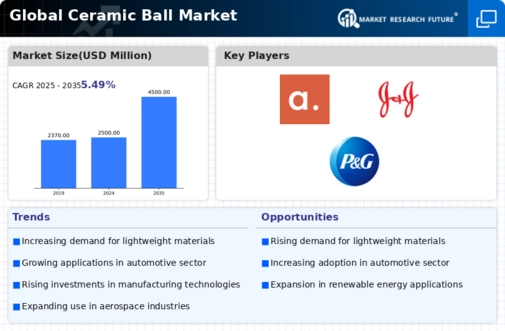Market Trends
Key Emerging Trends in the Ceramic Ball Market
The ceramic ball market is undergoing significant trends that shape its dynamics in various industries. Ceramic balls, known for their high resistance to wear and corrosion, find applications in diverse fields, including bearings, valves, and grinding media. One prominent trend is the increasing demand for ceramic balls in the automotive and aerospace industries. As these sectors emphasize efficiency, reduced friction, and extended component lifespan, the superior properties of ceramic balls make them an attractive choice for use in bearings and other critical components, contributing to enhanced performance and reliability.
Moreover, the market is experiencing a surge in demand for ceramic balls in the medical and healthcare sector. The inert and biocompatible nature of ceramic materials makes them suitable for medical applications, including prosthetics, joint replacements, and dental implants. As the aging population grows and the demand for advanced medical devices increases, ceramic balls play a crucial role in providing durable and biocompatible solutions. This trend is likely to continue as medical technology advances and the need for long-lasting and reliable implants rises.
Additionally, there is a growing emphasis on sustainability and environmental responsibility in the ceramic ball market. Manufacturers are exploring eco-friendly production processes and materials to minimize the environmental impact of ceramic ball production. This trend aligns with the global push towards sustainable practices and the reduction of carbon footprints. Companies are investing in research and development to discover innovative methods that reduce energy consumption, waste generation, and the use of hazardous substances in the manufacturing of ceramic balls.
Furthermore, the market is witnessing a shift towards the use of ceramic balls in chemical processing and grinding applications. The chemical resistance and hardness of ceramic balls make them ideal for use in grinding and milling processes, where they can withstand harsh chemicals and high temperatures. The expanding chemical industry, driven by increased manufacturing activities, contributes to the growing demand for ceramic balls in processes such as catalysis and material dispersion.
The advent of advanced technologies is also influencing the ceramic ball market. The incorporation of precision engineering and ceramic nanotechnology in the manufacturing process results in ceramic balls with enhanced properties, such as increased hardness, improved surface finish, and better dimensional accuracy. These advancements contribute to the overall performance of ceramic balls in critical applications, making them more attractive to industries seeking high-performance materials.
Despite these positive trends, challenges exist within the ceramic ball market. The high cost of ceramic balls compared to conventional steel balls can be a limiting factor, especially in cost-sensitive industries. Additionally, issues related to the brittleness of ceramics may arise in certain applications, requiring careful consideration and engineering solutions to prevent breakage and ensure optimal performance.






Leave a Comment